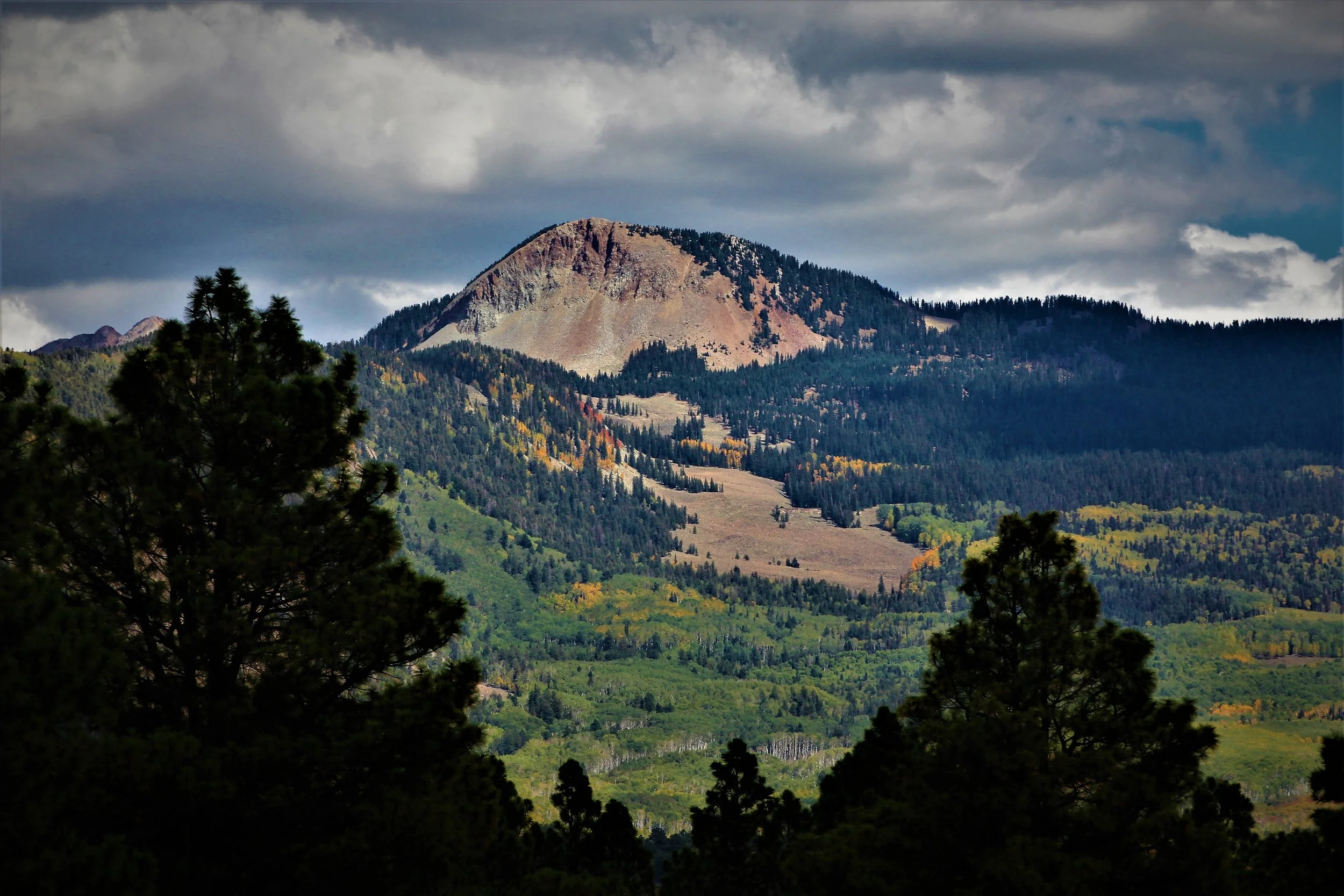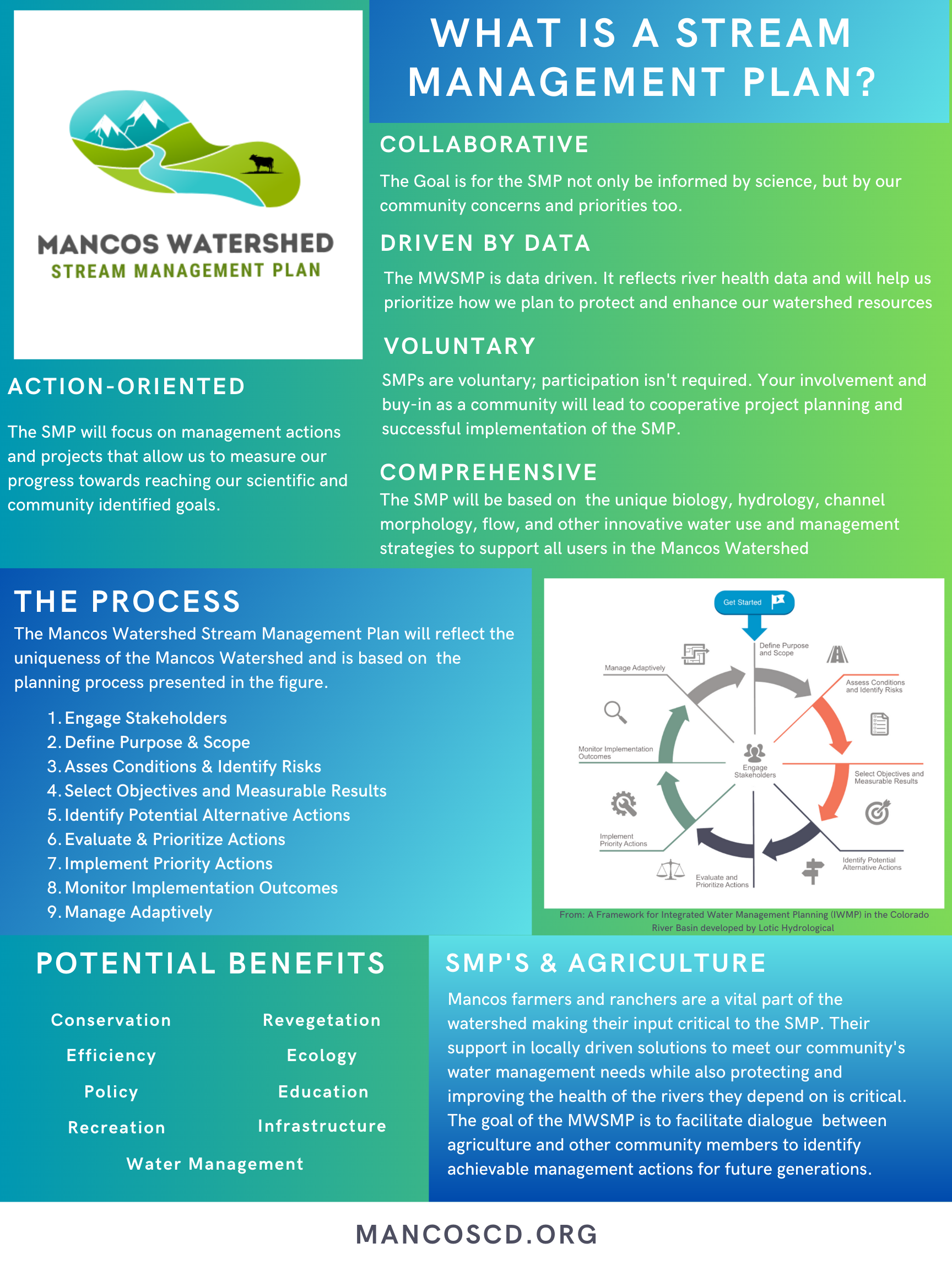
Mancos Watershed Stream Management Plan
Beginning in 2020, the Mancos Watershed Group began gathering stakeholder feedback in an effort to create a community-driven, data-informed stream management plan. Since the process began, over seventeen events have gathered feedback from more than 350 people in the Mancos Watershed. This dedicated stakeholder effort has resulted in the creation of a plan that the Mancos watershed community can use as a guide for protecting and enhancing the forest and water resources in the Mancos Watershed. The Mancos Watershed Group is excited to share the 2nd Draft Mancos Watershed Stream Management Plan.
This Google Folder contains several documents:
The Draft Mancos Watershed Stream Management Plan
Appendix A: MWSMP Recommended Actions
Appendix B: MWSMP Goals & Objective
Other Documents Referenced in the MWSMP
We recognize that there is a wide array of water users and values connected to the Mancos River. Care was taken to ensure the MWSMP is comprehensive and representative of the wide diversity of stakeholders in the watershed. The goal is to incorporate views and projects that would benefit multiple stakeholders and we welcome constructive feedback from stakeholders on how we can improve this plan and ensure it is meeting the goals outlined by the stakeholders and partners.
Next steps :
First, please read and review the document! Second, our comment period is open through Jan 2025. We will be collecting feedback through a variety of means:
A Google Form feedback opportunity
We are hosting several events that are can view via our events calendar.
Please stay tuned for more opportunities to provide this feedback, as we are working to make providing input efficient for community members. In the meantime, feel free to read through the MWSMP and enjoy seeing the product of our community's efforts over the last three years.
We'd also like to extend a sincere thank you to those of you who have dedicated time and effort to providing feedback and input to this community-driven process!
Some Background Info
The Mancos Watershed Stream Management Plan seeks to improve water security for all water uses and values in the Mancos Watershed by protecting existing uses, meeting user shortages, and maintaining a healthy riverine ecosystem. The geographic focus of this effort is the entire Mancos River watershed and its main tributaries. This diverse area encompasses Forest Service lands and Bureau of Reclamation facilities at the top end of the watershed, a productive irrigated valley in the middle, and Tribal and National Park lands towards the bottom end.
The specifics of climate uncertainly - like warmer temperatures, more frequent droughts. and variability of rainfall, paired with the vulnerability of forest and water resources to increased wildfire risk and severity precipitate the need for a stream management plan. Changes in land use and crop types may change historic surface flow patterns and exacerbate existing concerns about river health and flow shortages. A growing emphasis on recreation and community-wide engagement with the river further demand forward and collaborative thinking and planning.
The overarching goals of this first phase are to ensure protection of the current water rights, continued outreach and engagement, and to identify river health, recreational, and management opportunities on lands along the Mancos River through modeling, assessments, and monitoring coordination. The second phase will use data and information gathered during Phase I and beyond to assess, identify, and prioritize projects that further goals of the SMP. The objectives for Phase II propose building upon Phase I to provide recommendations for increased flows and restoration opportunities, identify potential projects for new and improved infrastructure, and facilitate changes to irrigation uses during below average run-off years. These opportunities, alongside those not yet anticipated, will incorporate the USBR Drought Resilience project's decision support framework to identify climate smart opportunities and future climate as a variable in the prioritization and implementation process.
Our Partners:
Mancos Conservation District (MCD), Ute Mountain Ute Tribe (UMUT), Mesa Verde National Park (MVNP), Town of Mancos (ToM), Mancos Water Conservancy District (MWCD), Mancos Watershed Group (MWG), Mountain Studies Institute (MSI)
Stream Management Plans
According to the Colorado Water Conservation Board, stream management plans are: “data-driven assessments of river health that help communities prioritize how to protect or enhance environmental and recreational assets in their watershed." In the case of the Mancos Watershed, stream management planning efforts also seek to identify opportunities for increased agricultural efficiencies and improved infrastructure.
Fluvial Hazard Zone Mapping
Fluvial Hazard Zone (FHZ) is the area a stream has occupied in recent history, may occupy, or may physically influence as it stores and transports water, sediment, and debris.
Fluvial geomorphic processes are natural phenomena within stream corridors and include commonly observed occurrences such as erosion, the transport and deposition of sediment, the recruitment and jamming of wood, and the structural influences of plants and animals.
Fluvial geomorphic processes become hazardous when they encounter infrastructure, houses, businesses, and other investments within and adjacent to the stream corridor. Fluvial Hazard Zone Maps are created by fluvial geomorphologists through the interpretation of data that describes the physical location, form, flooding intensity, active sediment and debris transport, and ecological conditions of the river system.
Fluvial Hazard Zone maps provide communities, property owners, and emergency response teams with information on flood- and stream- related hazards beyond those identified by traditional floodplain mapping. Additionally, as stream corridors are environmentally and economically important areas, Fluvial Hazard Zone maps can aid in prioritizing lands for conservation or maintenance of fluvial hazard compatible land uses.
Ag Producer Survey
The Mancos Conservation District has also partnered with Sarah McCarthy, a graduate student with Northern Arizona University and the Intermountain West Transformation Network to offer a survey for agricultural producers in Montezuma County.







